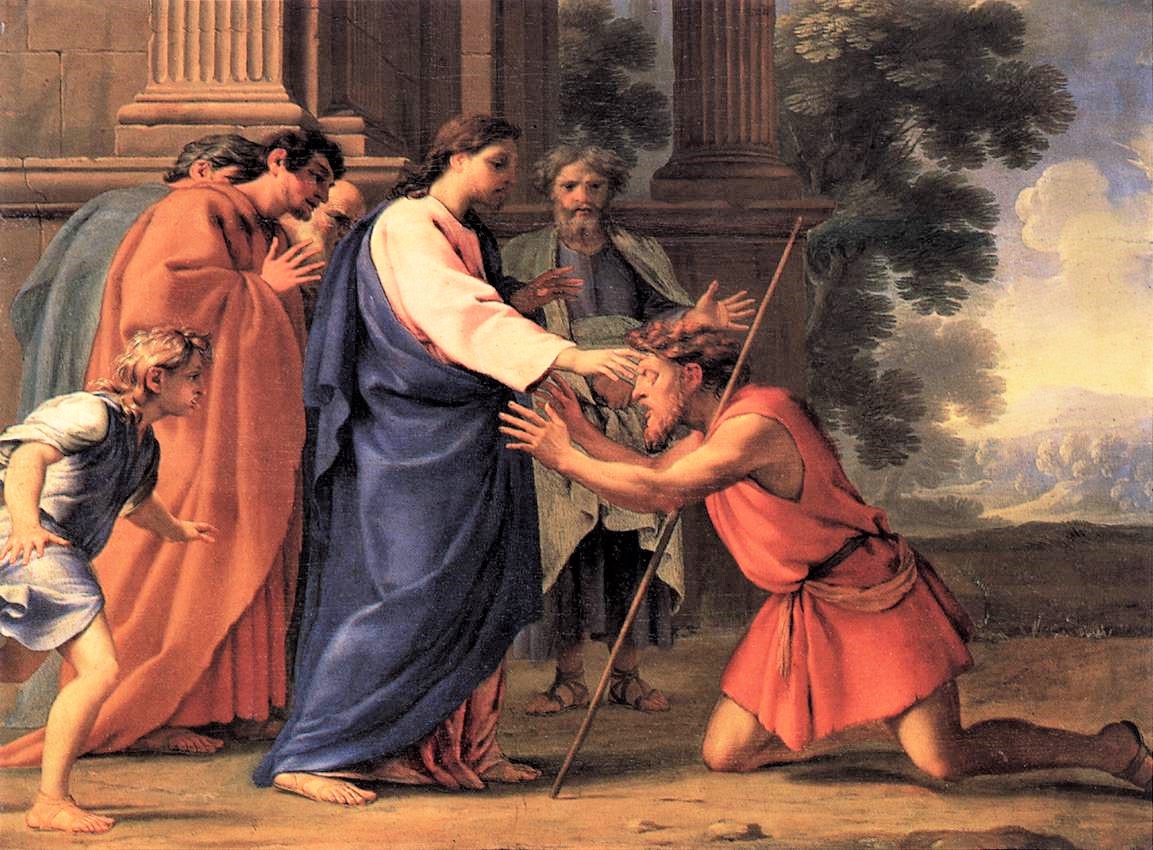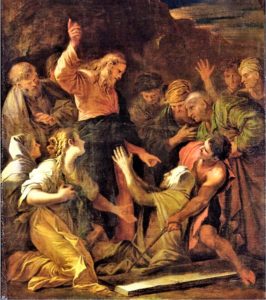In the Gospel this Sunday, we see the healing of a leper (this means you and me). In Scripture, leprosy describes more than just a physical affliction; it is a metaphor for sin as well. Obviously leprosy itself is not sin, but its effects are similar. Like leprosy, sin disfigures us; it deteriorates us; it distances us (lepers had to live apart from the community) and it brings death if left unchecked.
The following passage can be seen as comparing sin to leprosy:
There is no soundness in my flesh because of thy indignation; there is no health in my bones because of my sin. For my iniquities have gone over my head; they weigh like a burden too heavy for me. My wounds grow foul and fester because of my foolishness, I am utterly bowed down and prostrate; all the day I go about mourning … there is no soundness in my flesh … My friends and companions stand aloof from my plague, and my kinsmen stand far off (Psalm 38).
Perhaps a brief description of leprosy might be in order so that we can further appreciate both the physical disease and by analogy how sin gradually devastates us. I have compiled this description from several sources, among them, William Barclay’s Commentary on Mark.
Leprosy begins with an unaccountable lethargy and pains in the joints. Then there appear on the body, especially on the back, symmetrical discolored patches with pink and brown nodules and the skin becomes thickened. Gradually the symptoms move to the face and the nodules gather especially in the folds of the cheek, the nose, the lips, and the forehead. The whole appearance of the face is changed till a person loses his human appearance and looks more like a lion. The nodules grow larger and larger and they begin to ulcerate, and from them comes a foul discharge of pus. The eyebrows fall out and the eyes become staring. The voice becomes hoarse and the breath wheezes because of the ulceration of the vocal cords. Eventually the whole body becomes involved. Discolored patches and blisters appear everywhere. The muscles waste away; the tendons contract until the hands look more like claws. Next comes the progressive loss of fingers and toes until a whole hand or foot may drop off. It is a kind of a terrible and slow, progressive death of the body.
The disease may last from ten to thirty years and ends in mental decay, coma, then finally death.
Yet this was not all. The lepers had to bear not only the physical torment of the disease, but also the mental anguish and heartache of being completely banished from society. They were forced to live outside of town in leper areas. Everyone they knew and loved was lost to them and could only be seen from a distance.
In the middle ages, when people were diagnosed with leprosy, they were brought to the Church and the priest read the burial service over them, for in effect they were already dead, though still alive.
This description of leprosy shows how the illness develops, how it disfigures, deteriorates, and distances the leper. At that time, not every diagnosis of leprosy was accurate (there are many skin conditions that can resemble leprosy in its early stages). If the skin cleared up or at least did not deteriorate, the supposed leper could be readmitted to the community.
What about us spiritual lepers? How are we to find healing? Today’s Gospel suggests four steps to find healing from the spiritual leprosy of sin.
1. Admit the Reality – The text says, A leper came to Jesus, and kneeling down, begged him and said, “If you wish you can make me clean.” The man knows he is a leper; he knows he needs healing. He humbles himself and pleads for cleansing.
Do we know our sin? Do we know we need healing? Are we willing to ask for it? We live in times in which sin is often made light of; confessional lines are short. We often excuse our faults by blaming others or perhaps we point to some other sinner who is apparently “worse” than we are and think, “Well, at least I’m not as bad as he is.”
All of us are loaded with sin. We can be thin-skinned, egotistical, unforgiving, unloving, unkind, mean-spirited, selfish, greedy, stingy, lustful, jealous, envious, bitter, ungrateful, smug, superior, angry, vengeful, aggressive, unspiritual, and un-prayerful. Even if everything on that list doesn’t apply to you, certainly many of them do, at least at times. And that list isn’t even complete! We are sinners with a capital S and we need serious help.
Like the leper in the Gospel, we must start with step one: admitting the reality of our sin and humbly asking the Lord for help.
2. Accept the Relationship – Notice two things:
First, the leper calls on the Lord Jesus. In effect, he seeks a relationship with Jesus, knowing that it can heal him.
Second, note how the Lord responds. The text says that Jesus is moved with pity and touches him. The English word “pity,” though often considered condescending, comes from that Latin pietas, which refers to familial love. Jesus sees this man as a brother and reaches out to him in that way. Jesus’ touching of the leper was an unthinkable action at that time; no one would venture near a leper let alone touch one. Lepers were required to live outside of town, typically in nearby caves. But Jesus is God and He loves this man; in His humanity, He sees this leper as a brother. Scripture says,
For he who sanctifies and those who are sanctified have all one origin. That is why he is not ashamed to call them brethren, saying, “I will proclaim thy name to my brethren, in the midst of the congregation I will praise thee” (Heb 2:11).
It is in our relationship with the Lord, a relationship established by faith, that we are justified, transformed, healed, and ultimately saved. If we want to be free of the leprosy of our sin, we must accept the saving relationship with Jesus and let Him touch us.
3. Apply the Remedy – Having healed the leper, Jesus instructs him to follow through in the following manner: See that you tell no one anything, but go, show yourself to the priest and offer for your cleansing what Moses prescribed; that will be proof for them.
Among the ancient Jews it was the priests who were trained to recognize leprosy and distinguish it from ailments with similar symptoms. Priests were trained to observe and then make the final determination. A confirmed leper was banished from the community. Sometimes, out of an abundance of caution, a person was expelled on suspicion of leprosy, but the condition cleared up or remained stable. It was the priest who made the decision for the community as to whether the person should be readmitted.
Of course this is a metaphor for sacramental confession. What does the priest do in a sacramental confession? He assesses a person’s spiritual condition. If he sees God’s healing mercy at work in the person’s repentance, he reconciles him. In the case of a serious sinner who repents, the priest readmits him into the full communion of the Church. It is God who forgives, but He ministers through the priest.
To us spiritual lepers, the Lord gives the same instruction: go, show yourself to the priest …” In other words, “Go to confession.” The Lord tells us that we should offer for our cleansing what is prescribed. That is to say, we should offer our penance.
Why should the leper bother to do that? After all, the Lord has already healed him. To this we can only answer, “Do what Jesus says: show yourself to the priest and offer your penance.” It is true that God can forgive directly, but it is clear enough from this passage that confession is to be a part of the believer’s life, especially in the case of serious sin.
4. Announce the Result – When God heals you, you feel that you have to tell someone. There’s just something about joy that can’t be hidden—and people notice when you’ve been changed.
That said, there are aspects of this Gospel that are perplexing: Jesus warns the healed leper not to tell a soul other than the priest.
This (and other passages in which the Lord issues similar commands for silence) is puzzling. The reason is made clear later in the passage. Jesus did not want His mission turned into a magic show at which people gathered to watch miracles occur and see “signs and wonders.” This man’s inability to remain silent means that Jesus can no longer enter a town openly and that many will seek Him for secondary reasons.
That said, commands to remain silent cannot hold for us who have this standing order: Go therefore and make disciples of all nations, baptizing them in the name of the Father and of the Son and of the Holy Spirit, and teaching them to obey everything I have commanded you. And surely I am with you always, to the very end of the age (Matt 28:19).
Hence it is clear that we need to shout what the Lord has done for us and give Him all the glory. When God acts in your life, there is joy that cannot be hidden or suppressed. If our healing is real, we cannot remain silent. To quote Jesus at a later point (when the Temple leaders told Him to silence His disciples), I tell you, if they keep quiet, the very rocks will cry out (Lk 19:40).
The heart of evangelization is announcing what the Lord has done for us. An old gospel song says, “I thought I wasn’t gonna testify … but I couldn’t keep it to myself, what the Lord has done for me!”
Yes, tell someone what the Lord has done. If your healing is real, you can’t keep quiet about it.
https://youtu.be/KNw04iBZnR8







